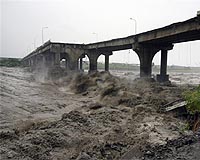| . |  |
. |
University Park PA (SPX) May 10, 2010 Potential climate change caused by rising levels of carbon dioxide might be better understood by examining fossil plant remains from millions of years ago, according to biogeochemists. The types of carbon within the leaves can serve as a window into past temperatures and environmental conditions. "Carbon isotopes are really important for understanding the carbon cycle of the past, and we care about the carbon cycle of the past because it gives us clues about future climate change," said Aaron Diefendorf, graduate student in geosciences at Penn State. Carbon naturally occurs in two non-radioactive isotopes - different forms of the same element - carbon 12 and carbon 13. Plants absorb carbon from the atmosphere as carbon dioxide. The ratio of carbon 12 to carbon 13 within a plant mirrors the ratio in the atmosphere, which varies with changes in the carbon cycle - the cycling of the element carbon through plants and animals, the ocean, the atmosphere and Earth's crust. Clues about how the environment responded to global warming events millions of years ago can be found in carbon isotope ratios from ancient fossil leaves, sediments and pollen. However, environmental conditions also impact leaf carbon isotope ratios, a complexity that Diefendorf and Kevin Mueller, graduate student in ecology, Penn State, set out to resolve with their study. Diefendorf and Mueller looked at published carbon isotope values from more than 3,000 modern plants, including a variety of plant types from diverse environments. Modern plant data allowed the researchers to examine how plant type, altitude and water availability affect the exchange of carbon isotopes between leaves and the atmosphere. "The relationship between temperature and carbon dioxide is really important to understand future climate change," said Diefendorf, whose research with Mueller, Scott Wing, department of paleobiology, Smithsonian Institute; Paul Koch, department of earth and planetary sciences, University of California, Santa Cruz and Katherine Freeman, professor of geosciences, Penn State, appeared in a recent issue of the Proceedings of the National Academy of Sciences. The researchers found that carbon isotope ratios in plants are strongly influenced by water availability. The relationship between water and leaf carbon isotope values has long been known to ecologists, but had not been observed at the global scale. The carbon isotope ratio was also dependent on plant type - evergreen or deciduous. To properly estimate carbon isotope ratios from the past, the authors suggest that future research must account for how water and plant type affect the relationship between atmospheric and leaf carbon isotope values. Temperature records along with accurate estimates of the past atmospheric-carbon-isotope values enable scientists to better understand how much warming is carbon-cycle-perturbation produced. This is applicable to the present rise in carbon dioxide. The researchers believe the environmental relationships highlighted in their study can be used to modify existing climate records to produce a more accurate, robust account of past atmospheric conditions and how it correlates with temperature change. "We know that climate is warming from increases in greenhouse gases as a result of human behavior - the science is clear - but understanding the additional feedbacks in the climate system that amplify this warming are crucial to understand future climate change," said Diefendorf. As the level of carbon dioxide in the atmosphere continues to rise, it is critical to use prehistoric events as models for how to control and adjust to the rapidly changing carbon cycle. "What we hope is that by using this approach (the patterns and relationships their research provides), we are going to get a better value for the carbon isotope ratio in the atmosphere, which you then plug into your model and get a better estimate for climate sensitivity," concluded Mueller.
Share This Article With Planet Earth
Related Links Penn State Climate Science News - Modeling, Mitigation Adaptation
 Rising sea levels threaten Taiwan
Rising sea levels threaten TaiwanTungshih, Taiwan (AFP) May 9, 2010 When worshippers built a temple for the goddess Matsu in south Taiwan 300 years ago, they chose a spot they thought would be at a safe remove from the ocean. They did not count on global warming. Now, as the island faces rising sea levels, the Tungshih township is forced to set up a new temple nearby, elevated by three metres (10 feet) compared with the original site. "Right now, the tem ... read more |
|
| The content herein, unless otherwise known to be public domain, are Copyright 1995-2010 - SpaceDaily. AFP and UPI Wire Stories are copyright Agence France-Presse and United Press International. ESA Portal Reports are copyright European Space Agency. All NASA sourced material is public domain. Additional copyrights may apply in whole or part to other bona fide parties. Advertising does not imply endorsement,agreement or approval of any opinions, statements or information provided by SpaceDaily on any Web page published or hosted by SpaceDaily. Privacy Statement |